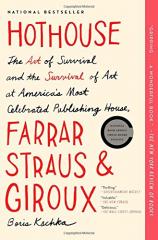Hothouse: The Art of Survival and the Survival of Art at America's Most Celebrated Publishing House, Farrar, Straus, and Giroux
Review
Hothouse: The Art of Survival and the Survival of Art at America's Most Celebrated Publishing House, Farrar, Straus, and Giroux
“Both Straus and Giroux had been exceedingly lucky. Their company exploited a glorious middle place --- geographically, culturally, and historically.” Boris Kachka, contributing editor at New York magazine, has brought to life an era and an ethos in this densely layered account of the birth, coming of age, and later chapters in the life of Farrar, Straus and Giroux, one of the most influential publishing houses of its heyday.
Birthed in the raucous nursery of New York City, pre- and post-WWII, when all the men were tough-minded, all the women were scintillating, and the aphorisms flowed like wine, FSG, with its three-fish logo, got its literary clutches on many of the best writers. These names were household words among the literati of their times: Hermann Hesse, Pablo Neruda, John Berryman, Carlos Fuentes, Thomas Merton, T. S. Eliot, Tom Wolfe, Flannery O’Connor, Susan Sontag, Nadine Gordimer --- all prize-winning artists in the FSG stable.
Kachka’s story makes for rich reading because the personalities were iconic. The two central characters are the Jewish scion, lady-killer Roger Straus, who wanted to run a classy, successful publishing business that would never “sell out” (though arguably it did, in the end), and the Catholic, working-class, impeccably well-educated and discreetly gay Robert Giroux, who succeeded in aligning himself with the intellectual in-crowd.
"Kachka’s story makes for rich reading because the personalities were iconic.... Every HOTHOUSE reader will cherish a favorite vignette..."
Every HOTHOUSE reader will cherish a favorite vignette --- about Straus and his power and vision, or Giroux with his sensitivity for spotting greatness. Here we see the young Jack Kerouac famously rushing into Giroux’s office in the 1950s “with a big roll of paper under his arm, as fat as a kitchen paper-towel roll.” It was his latest book, which he fully expected Giroux to embrace, as had been the case with his earlier, now forgotten first book, THE TOWN AND THE CITY. Based on its ho-hum sales, and perhaps on the monstrous editing job he had to do to cut it to saleable length, Giroux declined the classic ON THE ROAD.
Fast forward to the late 1980s, when Oprah Winfrey “picks” an FSG offering, THE CORRECTIONS, by Jonathan Franzen, who then makes the mega-mistake of saying that appearing on her show “might not sit well…with the readers who have been my core audience.” Oprah’s imprimatur would have “sent sales…into the stratosphere,” but FSG officially had to defend its author with faint praise.
The phrase “sexual sewer” came from Straus’s own wife, describing the steamy ambience of the FSG office at the height of its stardom. HOTHOUSE dishes out quite a bit of hot gossip from those old days, but they are old, and most of the actors have passed on, including Straus and Giroux themselves, so one hopes the damage is minimal.
The reins at FSG were taken up in latter years by Jonathan Galassi, about whom Kachka declares, if he didn’t exist, “FSG would have had to invent him.” Hammering his contention that the FSG grandeur petered out because of Straus’s unwillingness to let his son take over his business, Kachka concludes that Galassi lacks the power, and the free hand, of his predecessors: “The old aristocratic order of Roger Straus has given way to a world of uniformity and accommodation. No longer do emperors roam the halls...” Still, it's pleasant for a new generation to be able to stalk those imaginary hallways and breathe the air of intellectual greatness.
Reviewed by Barbara Bamberger Scott on August 16, 2013
Hothouse: The Art of Survival and the Survival of Art at America's Most Celebrated Publishing House, Farrar, Straus, and Giroux
- Publication Date: August 12, 2014
- Genres: History, Nonfiction
- Paperback: 448 pages
- Publisher: Simon & Schuster
- ISBN-10: 1451691912
- ISBN-13: 9781451691917





